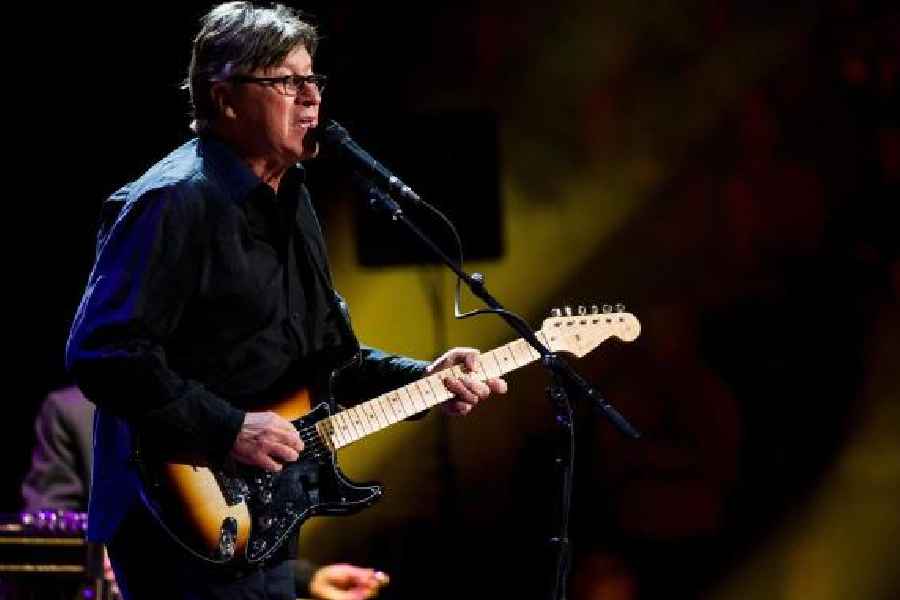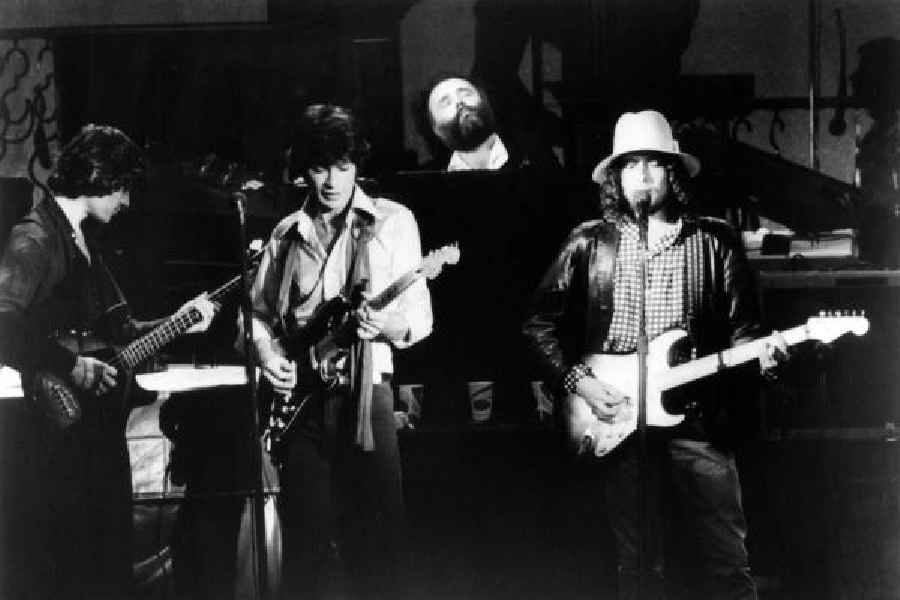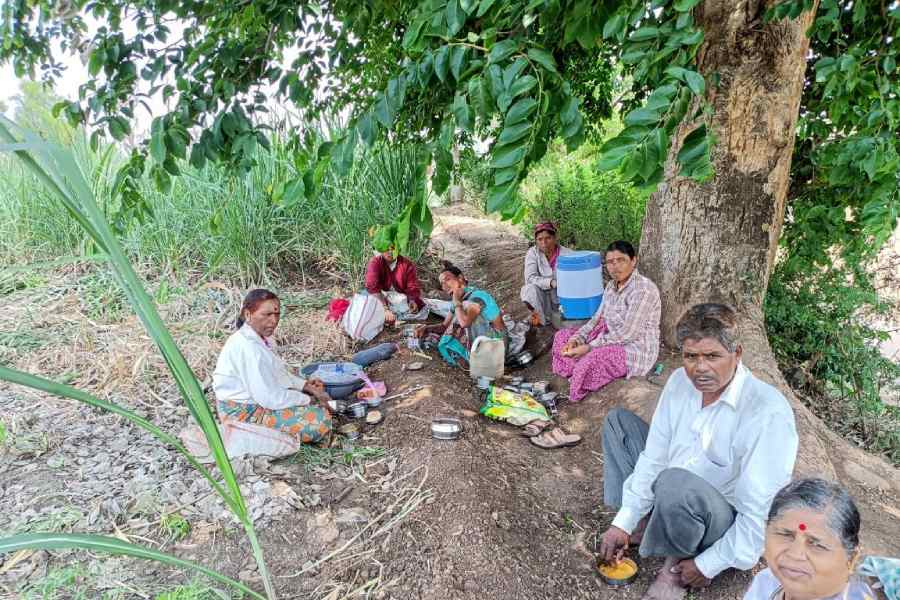By the mid-1970s, the Band was well known as the group that had backed Bob Dylan on his first electric tour and released a series of its own reverentially reviewed albums that returned music to a pre-psychedelic era and augured a return-to-basics movement in rock. But in 1976, with the quality and sales of its albums both declining, the Band announced a farewell show, full of illustrious guest stars, at the Winterland Ballroom in San Francisco on Thanksgiving Day. The gala concert would be filmed by Martin Scorsese, who in the last few years had directed the provocative and acclaimed films Mean Streets, Alice Doesn’t Live Here Anymore and Taxi Driver.
The music documentaries of the late ’60s and early ’70s — Don’t Look Back, starring a scabrous Dylan, in 1967, then the concert films Monterey Pop in 1968 and Woodstock in 1970, as well as the Rolling Stones debacle Gimme Shelter the same year — were low-budget affairs, underground in their lighting, camerawork and sound. D.A. Pennebaker shot Don’t Look Back by himself, using a hand-held camera and 16-millimeter film.
The Last Waltz — which put a spotlight on the Band’s guitarist and principal songwriter, Robbie Robertson, who died this week at 80 — was a confident, dramatic upgrade with an atypical structure. It begins with the concert’s final song, and incorporates band interviews and B-roll shots to give personality to each member.
Shades of purple
The 1978 film employs highly stylised backlighting and footlights, avoids audience shots and uses nearly every camera angle except low angle front, which is how bands are traditionally seen by members of an audience. The musicians dressed like western gunslingers ready to face their end, and to counteract all the mythic imagery, the interviews are full of the kind of artifice other films edit out, including awkward exchanges between the band members and Scorsese, their stumbling inquisitor. The movie dwells in shades of purple, the colour of bruises and cabernet sauvignon.
It didn’t take long for critics to laud The Last Waltz. In the British music weekly Record Mirror, Mike Gardner called it “the first rock movie to eschew the shambling amateurism that passes for rock cinema and replace it with the most illustrious professionals within Hollywood”. More resoundingly, Pauline Kael of The New Yorker (no big fan of cinéma vérité) wrote that it was “the most beautiful rock movie ever”.
These days, The Last Waltz is by consensus one of the best music films in the canon, neck and neck with Stop Making Sense, the Talking Heads concert film by Jonathan Demme. Many deconstructions of the Scorsese film describe it as a crucial and irreversible departure in rock film-making, a move away from naïve image-capturing and the “shaky camera” of Jonas Mekas, and toward canny image-making.
The star power in front of the camera — guests included Dylan, Neil Young, Joni Mitchell, Ringo Starr and Muddy Waters — was matched by the filmmaking expertise behind it. The crew included the director of photography Michael Chapman, plus seven camera operators, including the renowned Vilmos Zsigmond and Laszlo Kovacs, all shooting with 35-millimeter film, as well as the recording engineer and Neil Young collaborator Elliot Mazer. The production designer Boris Leven dressed the Winterland stage with columns, chandeliers and wall hangings from the San Francisco Opera’s staging of La Traviata, bringing some 19th-century Italian brio to the farewell concert.
Very sophisticated for the 1970s
How did it all come together? Once the Band decided to disband, Robertson wanted to find “someone special to capture this event on film,” he wrote in Testimony, his 2016 memoir. He considered most of the emerging young directors of the mid-70s — Hal Ashby, George Lucas, Francis Ford Coppola and Milos Forman — but picked Scorsese, who had been an assistant director and editor on Woodstock and was already considered gifted at using music cues onscreen, most notably Jackson Browne’s Late for the Sky in Taxi Driver, and Jumpin’ Jack Flash, by the Rolling Stones, in Mean Streets.
Robertson, the most sophisticated, charming and socially fluent member of the Band, met Scorsese through Jon Taplin, a Princeton graduate who had been a road manager for the Band, and later produced Mean Streets. Once Scorsese signed on, he asked for lyrics to each song in the concert, so he could plan camera movements and lighting changes. He eventually wrote a 200-page shooting script, according to Robertson. Other sources say it was 300 pages.
The director and the guitarist grew close, especially during postproduction, and pretty soon they were living together and jetting off to parties in Paris or Rome. That closeness caused friction: Despite the acclaim for The Last Waltz, some members of the Band felt that Robertson had made the film about him, rather than about them.
The drummer Levon Helm, whose superlatively soulful voice electrifies The Night They Drove Old Dixie Down and Up on Cripple Creek, made these criticisms public with the 1993 publication of his memoir This Wheel’s on Fire. He called the movie “a disaster” and accused Scorsese of making Robertson look great while ignoring other band members.
By then, Robertson and Helm had arrived at very different levels of success and financial comfort. “Robbie won. Levon lost,” Ken Gordon wrote in a 2015 essay in The Bitter Southerner. Some people reflexively side with winners, others with losers, and after Helm’s book came out, Robertson’s reputation suffered in some circles, and possibly influenced subsequent evaluations of The Last Waltz, especially after it was rereleased in theaters and on DVD in 2002.

Robbie Robertson
“The movie’s real subject is not the Band as a whole, but Robbie Robertson,” Stephen E. Severn wrote in Film Quarterly, adding that “virtually every visual and thematic aspect of The Last Waltz is designed to showcase his talents at the expense of the other members of the group.” Nonetheless, Severn affirms that it “may be the best film ever made about the music scene”, one that, unwittingly or not, reveals the cutthroat nature of the business.
Nearly 25 years after the release of The Last Waltz, its placement on lists of the best music documentaries was so common that the consensus around the film was ripe for a challenge. “The Last Waltz has inexplicably been called the greatest rock documentary of all time,” Roger Ebert wrote in 2002. In a re-evaluation of the movie that same year, Elvis Mitchell wrote in The New York Times that “part of the pleasure is in watching Robbie Robertson, the group’s leader, seduce Mr. Scorsese”.
The movie is more sceptically understood now, but its stature has never waned. Even its stoutest opponents recognize its quality. “Critics called the movie the best and most sumptuous film ever made about a rock concert,” Levon Helm wrote grumpily in his book, “and I suppose that’s true.”
Rob Tannenbaum (The New York Times News Service)










